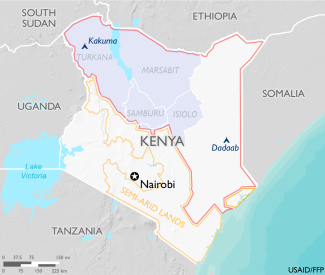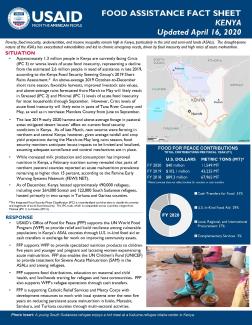April 16, 2020
Poverty, food insecurity, undernutrition, and income inequality remain high in Kenya, particularly in the arid and semi-arid lands (ASALs). The drought-prone nature of the ASALs has exacerbated vulnerabilities and led to chronic emergency needs, driven by food insecurity and high rates of acute malnutrition.
Situation
- Approximately 1.3 million people in Kenya are currently facing Crisis (IPC 3) or worse levels of acute food insecurity, representing a decline from the estimated 2.6 million people in need of assistance in late 2019, according to the Kenya Food Security Steering Group’s 2019 Short Rains Assessment.* An above-average 2019 October-to-December short rains season, favorable harvests, improved livestock sale values, and above-average rains forecasted from March to May will likely result in Stressed (IPC 2) and Minimal (IPC 1) levels of acute food insecurity for most households through September. However, Crisis levels of acute food insecurity will likely exist in parts of Tana River County until May, as well as in northeast Mandera County from June to September.
- The late 2019–early 2020 harvest and above-average forage in pastoral areas mitigated desert locusts’ effect on current food security conditions in Kenya. As of late March, new swarms were forming in northern and central Kenya; however, given average rainfall and crop yield projections during the March-to-May long rains season, food security monitors anticipate locust impacts to be limited and localized, assuming adequate surveillance and control mechanisms are in place.
- While increased milk production and consumption has improved nutrition in Kenya, a February nutrition survey revealed that parts of northern pastoral counties reported an acute malnutrition prevalence remaining at higher than 15 percent, according to the Famine Early Warning Systems Network (FEWS NET).
- As of December, Kenya hosted approximately 490,000 refugees, including over 264,000 Somali and 122,000 South Sudanese refugees, hosted primarily in two camps in Turkana and Garissa counties.
*The Integrated Food Security Phase Classification (IPC) is a standardized tool that aims to classify the severity and magnitude of acute food insecurity. The IPC scale, which is comparable across countries, ranges from Minimal (IPC 1) to Famine (IPC 5).
Response
- USAID’s Office of Food for Peace (FFP) supports the UN World Food Program (WFP) to provide relief and build resilience among vulnerable populations in Kenya’s ASAL counties through U.S. in-kind food aid or cash transfers in exchange for work on improving community assets.
- FFP supports WFP to provide specialized nutrition products to children five years and younger and pregnant and lactating women experiencing acute malnutrition. FFP also enables the UN Children’s Fund (UNICEF) to provide treatment for Severe Acute Malnutrition (SAM) in the ASALs and among refugees.
- FFP supports food distributions, education on maternal and child health, and livelihoods training for refugees and host communities. FFP also supports WFP’s refugee operations through cash transfers.
- FFP is supporting Catholic Relief Services and Mercy Corps with development resources to work with local systems over the next five years on reducing persistent acute malnutrition in Isiolo, Marsabit, Samburu, and Turkana counties through multi-sectoral activities.
Food for Peace Contributions
Total Contributions:
| U.S. Dollars | Metric Tons | |
|---|---|---|
| Fiscal Year 2020 | $40 million | 11,549 MT |
| Fiscal Year 2019 | $102.1 million | 43,235 MT |
| Fiscal Year 2018 | $89.3 million | 67,965 MT |
Country Specific Guidance
Related Resources


